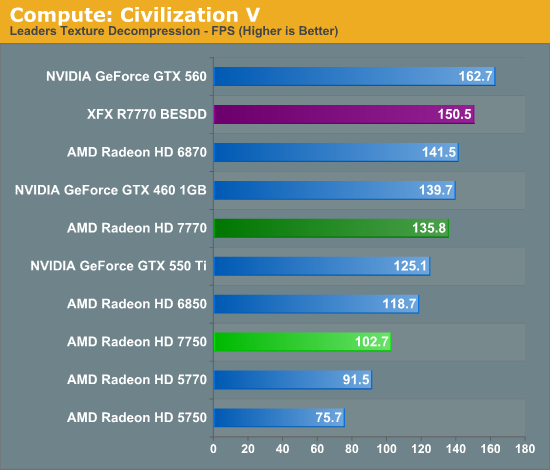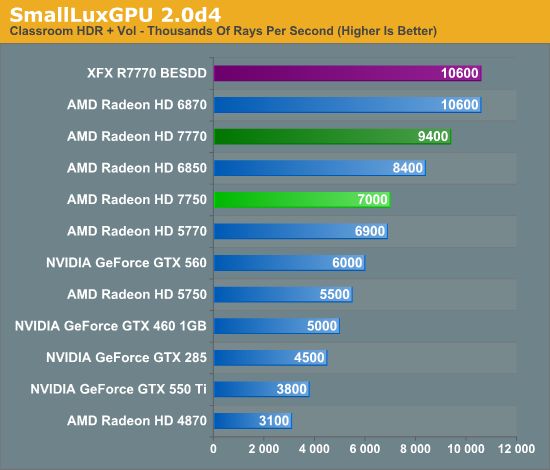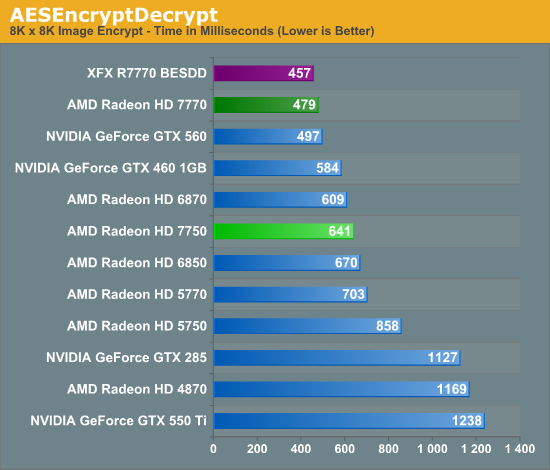AMD Radeon HD 7750 & Radeon HD 7770 GHz Edition Review: Evading The Price/Performance Curve
by Ryan Smith & Ganesh T S on February 15, 2012 12:01 AM EST- Posted in
- GPUs
- AMD
- HTPC
- GCN
- Radeon HD 7000
Compute Performance
Moving on from our look at gaming performance, we have our customary look at compute performance. With GCN AMD significantly overhauled their architecture in order to improve compute performance, as their long-run initiatives rely on GPU compute performance becoming far more important than it is today.
With such a move however AMD has to solve the chicken and the egg problem on their own, in this case by improving compute performance before there are really a large variety of applications ready to take advantage of it. As we’ll see AMD has certainly achieved that goal, but it raises the question of what was the tradeoff for that? We have some evidence that GCN is more efficient than VLIW5 on a per-shader basis even in games, but at the same time we can’t forget that AMD has gone from 800 SPs to 640 SPs in the move from Juniper to Cape Verde, in spite of a full node jump in fabrication technology. In the long run AMD will be better off, but I suspect we’re looking at that tradeoff today with the 7700 series.
Our first compute benchmark comes from Civilization V, which uses DirectCompute to decompress textures on the fly. Civ V includes a sub-benchmark that exclusively tests the speed of their texture decompression algorithm by repeatedly decompressing the textures required for one of the game’s leader scenes. Note that this is a DX11 DirectCompute benchmark.

Theoretically the 5770 has a 5% compute performance advantage over the 7770. In practice the 5770 doesn’t stand a chance. Even the much, much slower 7750 is ahead by 12%, meanwhile the 7770 is in a class of its own, competing with the likes of the 6870. The 7770 series still trails the GTX 560 to some degree, but once again we’re looking at the proof of just how much the GCN architecture has improved AMD’s compute performance.
Our next benchmark is SmallLuxGPU, the GPU ray tracing branch of the open source LuxRender renderer. We’re now using a development build from the version 2.0 branch, and we’ve moved on to a more complex scene that hopefully will provide a greater challenge to our GPUs.

SmallLuxGPU is another good showing for the GCN based 7700 series, with the 7770 once again moving well up the charts. This time it’s between the 6850 and 6870, and well, well ahead of the GTX 560 or any other NVIDIA video cards. Throwing in an overclock pushes things even farther, leading to the XFX BESDD tying the 6870 in this benchmark.
For our next benchmark we’re looking at AESEncryptDecrypt, an OpenCL AES encryption routine that AES encrypts/decrypts an 8K x 8K pixel square image file. The results of this benchmark are the average time to encrypt the image over a number of iterations of the AES cypher.

Under our AESEncryptDecrypt benchmark the 7770 does even better yet, this time taking the #2 spot and only losing to its overclocked self. PCIe 3.0 helps here, but as we’ve seen with the 7900 series there’s no replacement for a good compute architecture.
Finally, our last benchmark is once again looking at compute shader performance, this time through the Fluid simulation sample in the DirectX SDK. This program simulates the motion and interactions of a 16k particle fluid using a compute shader, with a choice of several different algorithms. In this case we’re using an (O)n^2 nearest neighbor method that is optimized by using shared memory to cache data.

It would appear we’ve saved the best for last, as in our fluid simulation benchmark the top three cards are all 7700 series cards. This benchmark strongly favors a well organized cache, leading to the 7700 series blowing past the 6800 series and never looking back. Even NVIDIA’s Fermi based video cards can’t keep up.










155 Comments
View All Comments
mattgmann - Wednesday, February 15, 2012 - link
Don't forget, when the 4870 pricing was low, at the end of 2008, BOTH AMD and Nvidia were settling price fixing lawsuits. These companies have cheated before; they'll do it again.Hubb1e - Wednesday, February 15, 2012 - link
"Recessions are good for the rich... not so good for everyone else. "Really? So when the stock market lost 40% of its value and the rich lost 40% of their net worth, that was good for them?
The rich can ride out a recession better than the poor because they don't live paycheck to paycheck, but it sure as hell wasn't good for them.
Galidou - Sunday, February 19, 2012 - link
Maybe we can see 4870's with maximum performance/die size in mind pricing failure because it was performing close to the big die from Nvidia gtx2xx. Or maybe we can see the ''double performance from last gen'' tactic from Nvidia a fail when it means building a super big die with low performance/size ratio just to get that double performance motto... It was all a question of ''goal to attain'' from each company. One goal paid off more than the other that time.From an Nvidia's fanboy perception, the first will be true and the second unthinkable. From an ATI fanboy, the first will make no sense and the second will suit them well. From someone with no choosen side, both can be true.
But these 7770 and 7750 here, makes no sense, such small die with such performance for that price.....
Malih - Wednesday, February 15, 2012 - link
I agree, smells fishy, usually at this point nVidia would lower their card price.The latest price competitive part from AMD is the 6800 series. Probably have to wait for the 8800 series?
Kjella - Wednesday, February 15, 2012 - link
I know, I bought a 5850 before the MSRP hike for around $279 + VAT in 2009 and I just checked, it clearly beats a 7770 so a >$159 value today, maybe close to the $200 card being launched in March. The 6xxxx series I thought was just because they had to scrap the 34nm process and deliver essentially a refined 5xxx series, but now they're on 28nm and there's not much bang for the buck for those of us that already have a gaming card from the 4/5xxxx series. I hope this is just a temporary situation until nVidia gets their Kepler out, or I might just sit out another generation...eminus - Wednesday, February 15, 2012 - link
AMD has AMD (Accute Money Deficiency) right now so they need every penny they can gain.Cygni - Wednesday, February 15, 2012 - link
It seriously seems that the 4850/4870 was an incredible purchase. In 2009, you could get a 4850 for $99 dollars. And it STILL holds up to the top range cards.I mean we all know that Nvidia and AMD are playing the profit game 10 times harder than the performance game in this sector, simply because games can't press the limits of the hardware, but it's still impressive.
just4U - Wednesday, February 15, 2012 - link
I bought 4 cards in the 4x lineup..First a 4850 for $170, Second a 4870 for $199 Third a 4870 1G for $229 and lastly a 4830 for 140.. While I live in Canada I don't think prices ever came that low unless you got one helluva good deal.. $99 pricing for the 4850 wasn't the norm even late in its production run.
BPB - Wednesday, February 15, 2012 - link
I got mine real chaep at launch! BestBuy mispriced them. Still, not too much later there were good deals again and I got one for my daughter's desktop. These cards in CF still hold up well for 1920x1200 gaming. I would like to upgrade to better performance and lower power, but AMD is making that hard dollar-wise.Jorgisven - Wednesday, February 15, 2012 - link
Indeed. Best Buy had a 25% off all Visiontek cards the week of the 4850 launch, so I got mine at launch for $150. I then caught an amazing deal on a 4870 a few months later ($129 shipped), sold my 4850 for $140. I basically bought both for a net $140.I've been waiting for a good AMD card, but just haven't seen one. I've been tempted by the 560 Ti or 570, but they're still too expensive for my taste, and don't offer enough of an advantage to spend the cost of a PS3 on upgrading from an already decent GPU.
I'm rather disappointed with Red as of late.